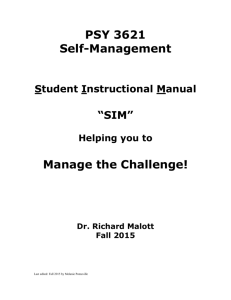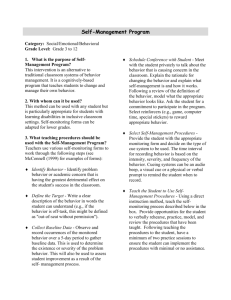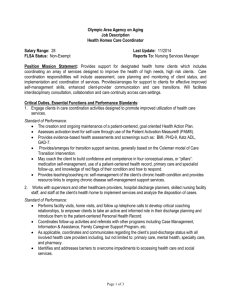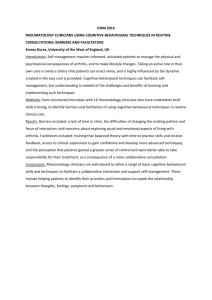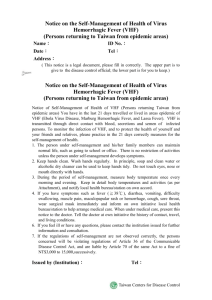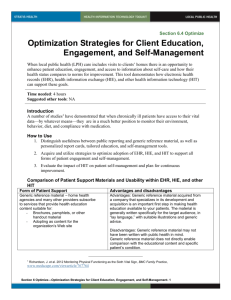SIM - Dick Malott.com
advertisement
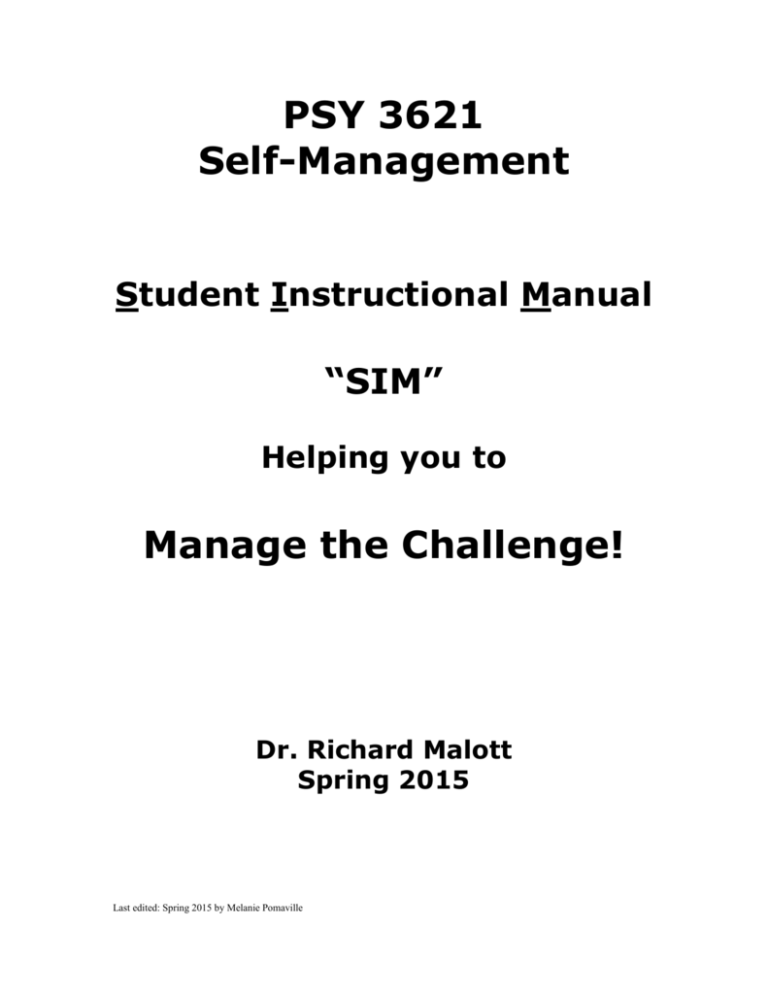
PSY 3621 Self-Management Student Instructional Manual “SIM” Helping you to Manage the Challenge! Dr. Richard Malott Spring 2015 Last edited: Spring 2015 by Melanie Pomaville Table of Contents INTRODUCTION ........................................................................................................................................ 2 CONTACT INFO ......................................................................................................................................... 2 COURSE STRUCTURE .............................................................................................................................. 3 ANALYSIS OF RECURRING TASKS ............................................................................................................... 3 Task Verification Form (TVF) .............................................................................................................. 3 Planner.................................................................................................................................................. 4 Academic and Non-academic Graphs ................................................................................................... 4 Weekly Self-Management Homework ................................................................................................... 5 Your Remaining Tasks .......................................................................................................................... 5 GRADE BREAKDOWN .............................................................................................................................. 6 CHEATING .................................................................................................................................................. 8 SAVING YOURSELF WITH SELF-MANAGEMENT ........................................................................... 9 Last edited: Spring 2015 by Melanie Pomaville Introduction1 Welcome to SelfManagement! The ultimate goal of this course is to provide you with the most efficient self-management intervention package possible. The course is aimed to serve collegelevel students who struggle to complete both academic and nonacademic tasks, who are sick of procrastinating, who have poor organizational skills, or who just need some extra management to keep them on track. Throughout the semester you will learn how to prioritize your work, how to break down tasks into smaller, more manageable components, and to organize yourself in order to be a successful student and professional. You will also graph your progress throughout the semester, giving you an in-depth analysis of your own behavior. Our goal is that you will take the skills you learn in this course and apply it to your everyday life. Self - management skills will not only benefit you as an 1 The Student Instructional Manual was written and designed by Matthew Brodhead in fulfillment of the Undergraduate Creative Research and Activities Award, and in partial fulfillment of his PSY 499 honors requirement, in Spring 2007. This document was also revised and includes contributions by Courtney Fox, in partial fulfillment of her PSY 499 honors requirement, in Spring 2007. Revised by Andrea Rau and Breanne Crooks as part of their MA project in Spring 2007. This document was also revised and includes contributions by Megan Baumgartner, in partial fulfillment of her PSY 499 honors requirement, in Spring and 2008. Revised by Melody Taylor and Andrea Rau as part of their MA project in Spring 2007, Madeline Budzen also revised this document in Fall 2008. Last edited: Spring 2015 by Melanie Pomaville undergraduate student, but will also assist you in graduate school, your career, and in many other areas of your life. The possible applications of self-management are endless. Even if you are a 4.0 student with an extraordinary resume of impressive work, you will benefit from this course. So hang tight, sit back, and enjoy the ride as we explore your behavior and shed new light on you as a student and a practitioner of applied behavior analysis! Contact Info Graduate Student Instructor Jake Adams Jacob.p.adams@wmich.edu Melanie Pomaville Melanie.m.pomaville@wmich.ed u Office: Wood Hall 2536 (BATS Lab) Office Hours: By appointment Self-Management Web site: http://dickmalott.com/psy3621-self-management/ Course Structure Every week when you come to class you will be required to present the following items (further explanation of these items is just ahead): A completed Task Verification Form (TVF) (for your completed assignments from the past week) o Proof of task completion for all self-assigned academic tasks nd A 2 completed TVF (with assignments you plan to complete over the course of the current week) An itinerary of classes you are currently enrolled in printed off of gowmu.wmich.edu Your SM planner filled out for the current week and for the following week An updated non-academic graph A completed Self-Management homework assignment Question 1: What are the six items you are required to bring to every Self-Management class? 1___________________________ 2___________________________ 3___________________________ 4___________________________ 5___________________________ 6___________________________ Last edited: Spring 2015 by Melanie Pomaville (Be sure to answer all of the questions in the SIM if you want to receive full credit. If you have any questions, your instructor will be more than happy to help answer them for you.) Analysis of Recurring Tasks Task Verification Form (TVF) The Task Verification Form is the heart and soul of the SelfManagement course. It contains your required, recurring weekly tasks as well as your weekly selfassigned tasks. Each week you will hand in your TVF and provide proof of your task completion. You will also present a TVF with tasks you plan to accomplish; your instructor will sign this TVF, verifying the commitment you made to complete those tasks. Also, all TVFs are to be filled out in pen and must not contain white-out or any similar marking agents. This is to make sure that you do not change the tasks you assign yourself. If your TVF is not signed, if it is not written in pen, or if it contains white-out or any other marking agent, you will receive a ZERO for the day. Question 2: In order to avoid getting a zero for the day, the TVF… A. Must not contain whiteout B. Must be written in pen C. Must contain an instructor’s signature D. All of the above If you answered “D”, you are correct! You will find a sample Task Verification Form in reference materials section of the SIM. Be sure to look it over, and if you have any questions, be sure to ask your instructor in order to avoid losing points. Planner You are required to keep your planner updated with notes of important dates, such as test dates and deadlines for homework. Your planner must contain all of your work and commitments for the next two weeks, but feel free to write in stuff for the next few months if you would like. Feel free to be as creative as you would like with your planner. In the past, some students have color-coded their planners to correspond to certain types of tasks. For example, one student wrote all of her normal priority tasks in blue, while her high priority tasks were red, and her minor detail tasks were green. Question 3: How far in advance must the planner be (minimally) filled out in order to receive credit? A. B. C. D. 1 day 1 week 2 weeks An epoch Academic and Non-academic Graphs You will be required to plot your progress and present it each week on a graph. You will learn how to plot your academic and non-academic performance on the first day of class. Plotting your progress will provide you and your instructors with a detailed analysis of your weekly behavior. It serves as an excellent mode of positive reinforcement. Hopefully, students who fail to meet their goal will find the disapproval of their classmates aversive enough to get their work done for the following week in order to avoid another episode of embarrassment. Example: Let’s say you exercised three times during your first week. You would find Week One on the X axis of the graph, and then find “3” on the Y axis; put your dot on that spot, and then draw a line all the way down to the tick mark above the corresponding week. If you exercised four times during the second week, and one time during the third week, you would mark the graph using the same method. Question 4: Complete the graph below using the example above: 5 4 3 2 Your planner must be filled out at least two weeks in advance if you would like to receive credit. Last edited: Spring 2015 by Melanie Pomaville 1 Week 1 Week 2 Week 3 B. False Does your graph look anything like this? 5 4 True. As long as you put in the effort requested by your SelfManagement instructor, you will do well in the course. Your Remaining Tasks 3 2 1 Week 1 Week 2 Week 3 If so, congratulations! If not, please revise, and be sure to ask your instructor if you have any questions about filling out a graph. Remember, you will be doing this all semester for both your academic and non-academic graphs. Weekly Self-Management Homework Sometimes you will be instructed to employ an organizational technique. The purpose of your weekly selfmanagement homework is to give you the opportunity to test drive a number of self-management techniques that may be successful with improving your selfmanagement skills. Question 5: Self-Management homework is important, and should be taken seriously in order to improve your self-management techniques, no matter how skilled you may be. A. True Last edited: Spring 2015 by Melanie Pomaville The remaining spaces on your TVF are reserved for academic tasks of your choice. Good examples of academic tasks include “Study for PSY 4600” or “Complete study guide for chapter 4 of Economics”. A majority of your work in this course will be from this section of your TVF. You will learn how to assign yourself academic tasks during your first homework assignment, so for now we will leave you with a reminder from our sponsor… Important reminder: Remember to bring tangible proof of completion for each task to class in order to receive full points! Acceptable forms of proof include: Written notes from a chapter Note cards Receipts Written documents (such as literature reviews) Pictures Additions or changes to a document using Track Changes Proof of active reading You will complete a worksheet that covers showing proof of task completion in more detail later on. Important: Highlighting is not acceptable proof ALONE. Take advantage of resources available to you, such as the 500 free pages available for each student to print at the computer lab in the library or the Bernhard Center. You can even bring your laptop to class and show proof of task completion that way. Class participation is based on attendance and is worth 20 points per week. Points will be deducted for tardiness and missed classes. Points also depend on your level of participation during class discussion, so don’t hesitate to offer your opinions! Five points will be deducted from your participation grade for every 15 minutes you are late for class. If you miss seminar you will lose 20 participation points for that week. If you are 1-15 minutes late, you will lose 5 participation points. If you are 16-30 minutes late, you will lose 10 participation points. If you are 31-45 minutes late, you will lose 15 participation points, and if you are more than 46 minutes late, or you do not show up for class at all, you will lose 20 participation points. Question 6: Students can print 500 free pages each semester at the Bernhard Center computer lab, or the library computer lab. Important note: You will need at least a 92% in participation to earn an A in the course. Don’t forget to bring the following items to class every week: Your completed TVF Your completed TVF for the following week Your planner Your academic graph Your non-academic graph Proof of your completed tasks Your weekly Self-Management homework A. True B. False The correct answer is “A”. Don’t hesitate to take advantage of the resources provided to students. After all, you are paying for them with your tuition. Grade Breakdown Participation Last edited: Spring 2015 by Melanie Pomaville Question 7: How many participation points will you lose if you are 20 minutes late for class? A. 5 B. 10 C. 15 D. 20 If you are between 16-30 minutes late, you will lose 10 participation points. Question 8: What is the minimum participation grade in order to get an A in Self-Management? A. B. C. D. 92% 88% 80% 76% Students must earn at least 92% in participation to get an A in SelfManagement. Question 9: Based on your answer from Question 8, how important is it to arrive at class on time, and to show up for every class? A. Very important B. Not so important Think about it this way: what is the point of taking a class called “SelfManagement” if you are going to arrive late every day? It defeats the purpose, right? Non-academic Project Your non-academic project will be an ongoing project that you will be working on this semester. Non-academic projects will share the same point category as participation, whereas you will need a 92% on your non-academic project if you would like an A in the course. A detailed explanation of your non-academic project will be given in future assignments. Tasks Each week you will be required to complete four tasks Last edited: Spring 2015 by Melanie Pomaville from each of your classes. If you are currently enrolled in five courses, you will be responsible for completing 20 tasks, along with all of your recurring Self-Management tasks (these recurring SelfManagement tasks [graphs, etc] will be worth one cumulative task), and your Self-Management homework. Starting Spring 2009, students must complete one “early bird” task for each class. An “early bird” task is a task that is not necessarily due the following week, but something that helps the student to be proactive about an assignment that is due two, three, or four weeks down the road. Your grade will be a function of the following formula: (# of tasks completed) (# of tasks assigned) 100 For example, if you assign yourself 22 tasks, and you only complete 20, your grade for the week will be approximately 91%, or 91 points. Self-Management is designed to teach students how to be successful task managers. In order to receive an A in the course, you must get at least a 97% in task completion. The standards are high in order to keep you on track, and to prevent you from procrastinating. And we know you’re sick of procrastinating, right? Question 10: A minimum of _____ in task completion is necessary to get an A in Self-Management. A. 92% B. 97% C. 80% D. Stunning good looks 78 DC Though stunning good looks may help you succeed in life, they won’t help you as much as completing all of your work. Therefore, it’s essential that students earn at least 97% in task completion in order to get an A in SelfManagement. Question 13: If a student has 86% in participation, and 85% in task completion, what is their grade in Self-Management, according to the Grading Matrix? _____ Grading Matrix Participation Task Completion 92 87 82 77 72 67 62 <62 97 A BA B CB C DC D 93 BA B CB C DC D E 89 B CB C DC D E C DC D E DC D E C E If you wrote “BA” you are correct! Let’s try another example… You need 92% in participation and 97% in task completion to get an A in Self-Management. 81 71 E Question 12: If a student has 90% in participation, and 98% in task completion, what is their grade in Self-Management, according to the Grading Matrix? _____ A. 92% B. 97% 85 CB D E The grading matrix gives a break down of your current grade. For example, if you have a 98% in task completion and an 86% in Participation, the highest grade you can receive is a B. Question 11: Students need _____ in participation and ______ in task completion to get an A in SelfManagement. Grade 75 D Cheating CHEATING MEANS SUDDEN DEATH! If we catch you cheating or plagiarizing in this course, you will Last edited: Spring 2015 by Melanie Pomaville E If you wrote “DC”, you are correct. To the untrained eye, 86% and 85% don’t sound too bad, especially to the student who is used to dabbling in the B range. However, this lethargy won’t fly in Self-Management, which is why it is crucial to perform as well as you possibly can. receive an E for the course, no matter how small or trivial the cheating or plagiarizing. Cheating includes, but is not limited to, copying from your neighbor, your notes, or whatever, during a test or quiz. This also involves talking during a test or quiz. Cheating also means copying someone else’s homework and turning it in as your own. Also, turning in a task you have used for a previous week counts as cheating. Plagiarizing means turning in written work that includes material taken from someone else, without using quotation marks or otherwise giving proper credit to the true author. A note from the WMU Faculty Senate’s Professional Concerns Committee: You are responsible for making yourself aware of and understanding the policies and procedures in the Undergraduate and Graduate Catalogs that pertain to Academic Honesty. These policies include cheating, fabrication, falsification and forgery, multiple submission, plagiarism, complicity and computer misuse. [The policies can be found at <http://www.wmich.edu/catalog>http:// catalog.wmich.edu under Academic Policies, Student Rights and Responsibilities.] If there is reason to believe you have been involved in academic dishonesty, you will be referred to the Office of Student Conduct. You will be given the opportunity to review the charge(s). If you believe you are not responsible, you will have the opportunity for a hearing. You should consult with your instructor if you are uncertain about an issue of academic honesty prior to the submission of an assignment or test Question 16: Students who cheat in SelfManagement… A. Will receive an “E” B. Will be referred for disciplinary action Last edited: Spring 2015 by Melanie Pomaville C. Are doing themselves disservice D. All of the above a Don’t be fooled, the answer is D. So it’s important to take your work seriously during this course, or any course for that matter. In fact, why don’t you just start taking yourself seriously right now, in case you haven’t already, that way, you’ll be setting yourself up for success, and not for failure. Saving Yourself with SelfManagement “The Super Cool Student” A long time ago in a place not so far away, there was a student whose life was heading down the wrong path. School was not a priority for this person. Instead, the student was surrounded with the wrong people, people who would not make it to the age of thirty due to their excessive drug use. These drugs weren’t soft drugs like marijuana and alcohol; they were the hard stuff, the stuff your mother always warned you about. Heroin, cocaine, and crack were just a few of the things she would dabble in on a daily basis. Curious about what all of the fuss was about, the student signed up for Self-Management. After hearing about the non-academic project, the student figured that it might be a good idea to kick the drug habit. After all, it was a problem that had been plaguing her for a long, long time. The student was low on cash and desperately in need of change. The student had already spent time in rehab once before, and nothing was accomplished. Fed up with bad friends and the way life was going, the student thought that with a little help from behavior analysis, she could get on the right track to the good life. And so it began. Things got off to a rocky start, and the drug use continued to be resistant to change. But the student remained persistent, and developed a complex behavioral strategy to track and manage her drug abuse. The method was so good that it impressed graduate students and professors alike, and the student soon began to see progress. As the student progressed throughout the semester, the built in, natural reinforcement of living a healthy life began to shape more positive, socially acceptable behaviors. The student took on new hobbies, began exercising, and kicked most of her other nasty habits. Not to mention, the student started doing well in school. Other students and teachers were shocked by the turn around the student had made. Now, the student is well on her way to becoming one of the world’s finest behavior analysts. This story shows that with a little hard work and a dedicated commitment to the behavioral principles, even the nastiest of behaviors can be dealt with and managed with some tight contingency control. Don’t let yourself fall by the wayside. As you go through life, trying to save the world with behavior analysis, don’t forget to save yourself along the way. You’ll be thankful when you’re 80 years old and still kickin’ strong. Last edited: Spring 2015 by Melanie Pomaville Question 17: Who was “The Super Cool Student?” A. A student who was always on the right track to success B. A student who probably invented the term “Falling off the wagon”, but managed to get their life into gear using SelfManagement C. A caricature of Spicoli from Dazed and Confused ~ 11 ~
